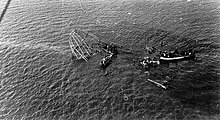LZ 40
| L 10 | |
|---|---|

|
|
| Type: | Zeppelin type p |
| Design country: | |
| Manufacturer: | |
| First flight: |
April 3, 1915 LZ 38 |
| Commissioning: |
L 10: May 13, 1915 |
| Production time: |
1915-1917 |
| Number of pieces: |
21st |
The Zeppelin LZ 40 was Count Zeppelin's 40th airship and the tenth zeppelin of the Imperial Navy with the military ID L 10 .
history
The LZ 40 was the first Zeppelin with four engines - instead of the previous three engines - as a drive. The airship belonged to the type p , of which a total of 21 airships were manufactured starting with LZ 38 , ten of which were delivered to the army and eleven to the navy. As the first pleasure ship in the Navy, it had a lifting gas volume of over 30,000 m³ hydrogen . With a length of 163.50 m, it was 2 m longer than the L 9 of the intermediate model o and 5.5 m longer than the first standard ships of the m type . Compared to these, the diameter increased from 14.9 to 18.7 m.
The first run of LZ 40 took place on May 13, 1915. The navy took over the airship under the military identification L 10 . Captain Hirsch became the commanding officer . The ship was stationed in Nordholz for reconnaissance trips over the North Sea and for bombing raids on Great Britain .
For its first bombing raid on London , L 10 took off shortly after midnight on June 4, 1915 in Nordholz. The ship's bomb load was two 100 kg bombs, 20 50 kg high explosive bombs and 90 incendiary bombs. Due to a strong headwind, London could not be reached before daybreak and so L 10 dropped its bomb load on Gravesend .
On June 16, 1915, L 10 bombed the industrial area on the Tyne with 2.5 tons of bombs and had a great impact by damaging industrial facilities. During this bombing raid, the airship avoided the attack of a British aircraft, which could not follow the zeppelin at such a height, by ascending to a great height.
Further bombing raids against Sheppey and Harwich followed. L 10 launched its last attack on England on August 17, 1915 on London with 1.4 tons of bombs.
End of LZ 40 / L 10
During a trip in a thunderstorm on September 3, 1915 near Cuxhaven , the gas that had been blown off ignited and the airship burned in the air. There were no survivors.
Hans von Schiller, as an officer on board the airship L 11, described a similar voyage in a thunderstorm over the North Sea : “The lightning bolts flicker across entire areas. A tremendous blow numbs my ear and fills the inner aisle with blinding light, a flash of lightning drove past the Zepp into the sea. The man at the upper lookout calls down that the muzzles of his machine guns are spraying sparks. I climb up the riser to see what's going on. To my surprise, I find the platform brightly lit. The sentry sits in the midst of this light, soaked to the skin, and has a downright halo around his head. The strange appearance is not unknown to mountaineers, nor to skippers, they are called Elmsfeuer . The duralumin frame of the shell is also charged with electricity and sprays at all connection points, edges and sharp corners. If we look up from the driver's gondola, we can see for ourselves how the electricity creates sparks from all of the above. Wires and cables glow in shades of blue-violet, a wonderful sight, but we are not quite able to enjoy them. Because our people stumble like drunken tightrope walkers on the narrow metal walkway, and our lives all depend on the fact that no hydrogen gas escapes from the cells, while every two seconds a lightning bolt passes by, so to speak, at arm's length. "
Technical specifications
- Carrying gas volume: 31,900 m³ hydrogen
- Length: 163.50 m
- Diameter: 18.70 m
- Payload: 15 t
- Drive: four six-cylinder Maybach engines, each with 210 hp (154 kW)
- Speed: 26.7 m / s
See also
literature
- Peter Meyer: Airships - The History of the German Zeppelins. Wehr & Wissen, Koblenz / Bonn 1980.
Individual evidence
- ^ Ernst A. Lehmann : On air patrol and world travel. Wegweiser-Verlag, Berlin 1936, pages 157-159

